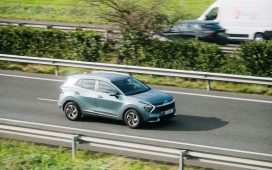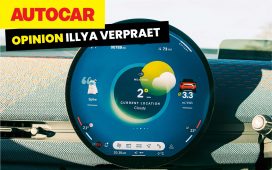A growing number of drivers in Catawba and Burke counties are plugging in rather than filling up.
Electric-vehicle registrations in both counties accelerated by more than 50% in 2022, outpacing the statewide growth rate of 46% for the year.
Overall, North Carolina added nearly 17,000 plug-in vehicles last year compared to an increase of about 13,000 in 2021. That growth rate would put North Carolina on pace to meet Gov. Roy Cooper’s goal of reaching at least 80,000 “zero-emission” registrations by 2025.
However, the state faces a steep climb to reach Cooper’s longer-term target of having 1.25 million EVs on the road by the end of this decade, an N.C. Department of Transportation official acknowledged.
“Certainly, we’re really excited about the progress,” said Jen Weiss, NCDOT’s senior adviser on climate change. “But I think there’s a lot of work to do just to make (electric vehicles) more mainstream, make people more aware of the benefits of EVs and get the charging infrastructure out there to make them more comfortable with range.”
People are also reading…
Alexander County (32%) and Caldwell County (25%) experienced slower growth in plug-in vehicles in 2022.
Across North Carolina, the saturation rate for electric vehicles in smaller counties continues to lag behind the state as a whole. Combined, Catawba, Caldwell, Burke and Alexander counties had about 26 EVs per 10,000 registered vehicles. Catawba, with 32 per 10,000, had the area’s highest electric-vehicle concentration.
Statewide, there are now 63 EVs per 10,000 registrations — a rate driven by North Carolina’s largest counties. Wake County reached 156 EVs per 10,000 vehicles in 2022 and Mecklenburg was at 113 per 10,000.
Those two counties, which represent 21.5% of the state’s population, accounted for 41% of North Carolina’s registered EVs, according to NCDOT.
One driver of plug-in vehicle use in the state’s two most-populous counties is that they’re home to North Carolina’s only Tesla sales centers.
Tesla is responsible for about two-thirds of electric vehicle sales in the U.S., so proximity is a boost for EV saturation in Wake, Mecklenburg and surrounding counties.
Concentrations of corporate headquarters, research centers and professional campuses in the Triangle and Charlotte region also mean there are plenty of residents in those areas who can afford the still-higher sticker prices for electric vehicles.
And in many cases, bigger companies are more likely to provide charging stations for employees who drive EVs.
More Tesla purchase options are coming soon, however. The Austin, Texas-based company is planning to add sales and service centers in Asheville and High Point.
‘Almost everywhere’
North Carolina classifies traditional EVs and plug-in hybrids (PHEVs) as “zero-emission” vehicles subject to the state’s registration goals.
About 29% of the state’s registered plug-in vehicles are PHEVs, but labeling them as entirely zero-emission is a misnomer because their exhaust emits carbon dioxide, a heat-trapping gas that is the primary contributor to human-caused climate change. However, the level of emissions is considerably less for plug-in hybrids compared to traditional gas-powered vehicles.
The chief benefit of PHEVs, compared to traditional hybrids that aren’t charged externally, is that they operate on electricity until the battery is nearly empty, which is why they’re classified as zero-emission by the state, the NCDOT’s Weiss explained.
“For the most part, when people are driving to work or to school, it’s 20 miles or 25 miles or less, so the commuting time is within the range of the plug-in hybrid,” she said.
As EVs take over, the concern is that their near noiselessness may make driving less fun. Bloomberg’s Stefan Nicola explains how some companies are replacing their sounds of silence with a new kind of roar.
State registrations for standard hybrids, meanwhile, climbed to nearly 168,000 in 2022, an increase of 11.5%.
No-plug hybrids — powered by an internal combustion engine and one or more electric motors — are not part of the state’s EV goals. Batteries in traditional hybrids are charged through energy generated when the vehicle’s brakes are applied and by the gas-powered engine when it is engaged, so they are continuously shifting between electric and gas-powered modes.
‘All-in strategy’
Weiss, who’s coordinating NCDOT’s effort to increase EV use, reduce vehicle emissions and create a statewide charging network, suggested that 2022’s growth in electric vehicles is a welcome sign of momentum.
“You’ve seen in just the last year all the (EV) manufacturers that are coming out with new kinds of models, different types of battery levels and price points,” she said. “I think it’s just going to be important for them to continue to do that, and for us as a state agency to just educate everyone in North Carolina about what those opportunities are.”
The Inflation Reduction Act, passed by Congress and signed by President Joe Biden last year, established $7,500 tax credits for EVs assembled in North America.
Eligible cars must be priced at $55,000 or less, while vans and sport utility vehicles can’t exceed $80,000.
Married couples filing joint tax returns who earn $300,000 or less qualify for the plug-in vehicle credit. The limit is $150,000 for individual filers.
In most cases, the $7,500 credit won’t cover the entire difference between an EV and comparable traditional vehicle with a combustible engine. For example, the base price of a 2023 Ford F150 Lightning is about $20,000 higher than a standard F-150, and there’s a $12,000 difference between a new Jeep Wrangler Sahara EV and its traditional counterpart.
But while upfront EV costs are higher, studies show that plug-in vehicles are considerably less expensive to maintain, and the cost of electricity for charging is a fraction of what owners would pay for gas over a car or truck’s lifetime.
Those selling points — along with a reliable network of charging stations and falling EV prices as battery costs continue to shrink — will continue to convince North Carolina drivers to plug in, Weiss predicted.
“We at DOT can’t tell anyone what kind of car to drive, and we don’t want to,” she said. “But we can certainly make available the different options and education on those options. It’s an all-in strategy. Everyone’s working together to make it happen.”











